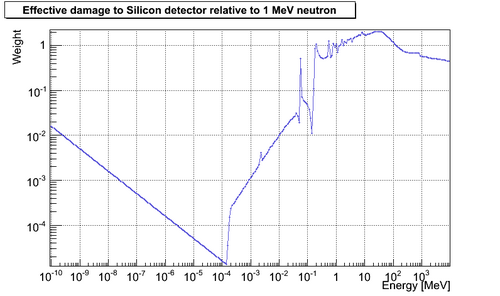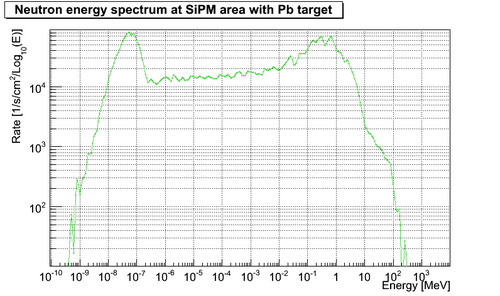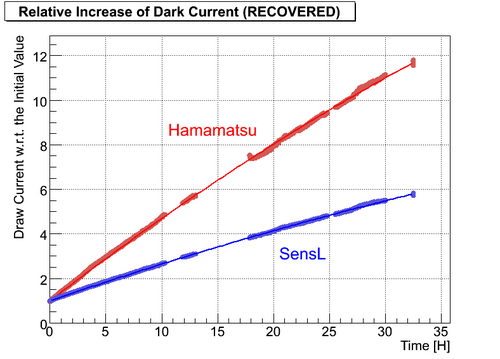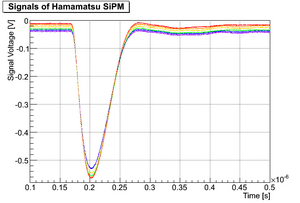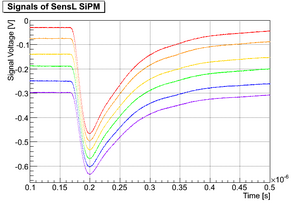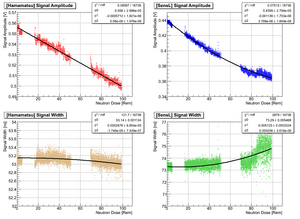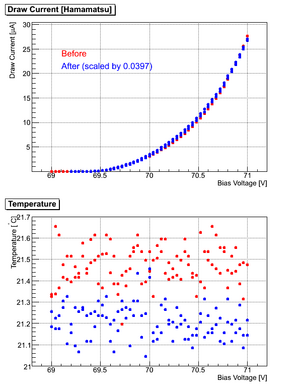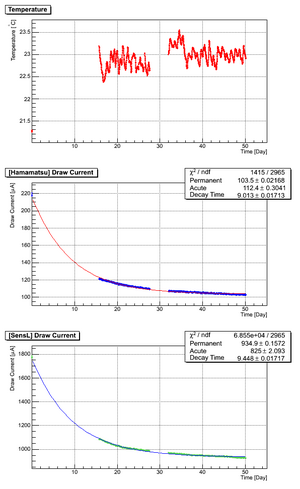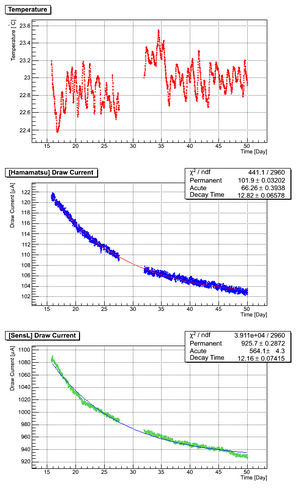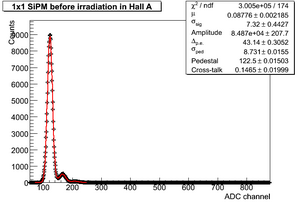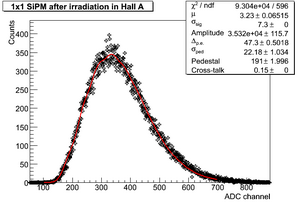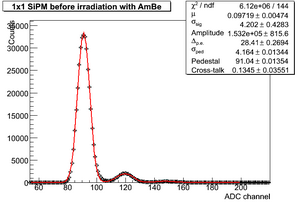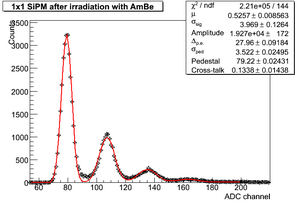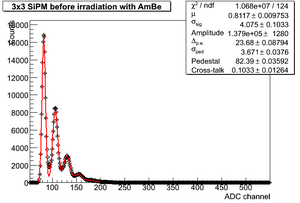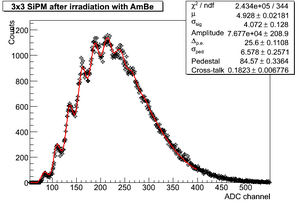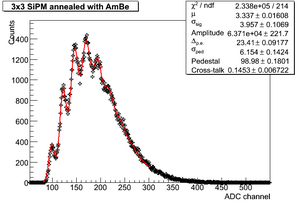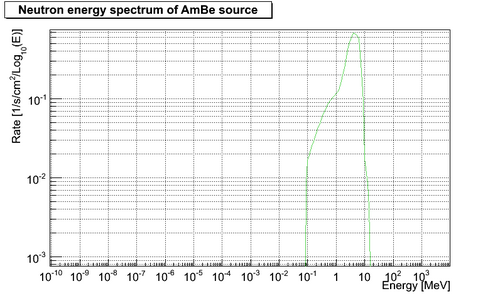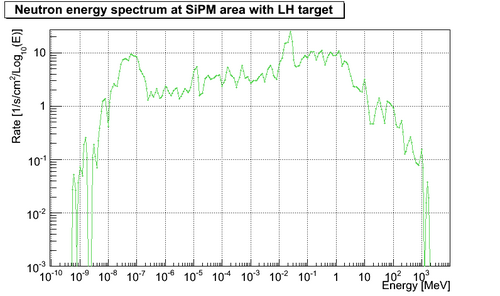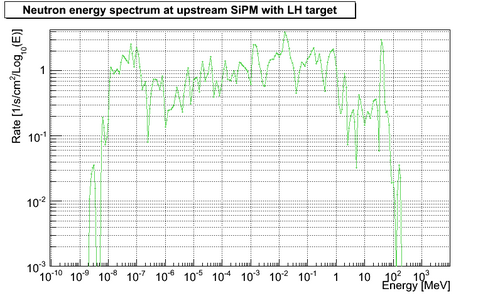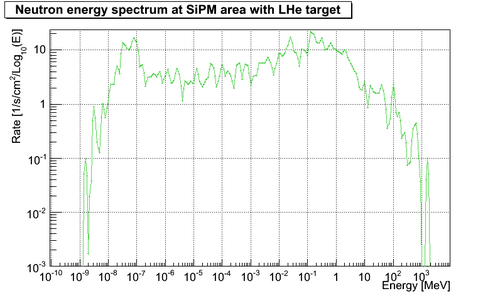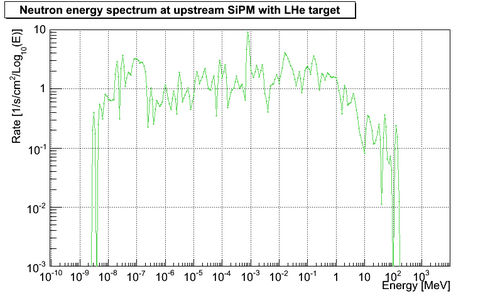SiPM Radiation Hardness Test
Contents
- 1 Introduction
- 2 Probing Neutron and Its Damage to Silicon Detectors
- 3 Irradiation in Hall A
- 4 Test with RadCon AmBe Source
- 5 Damage Conversion and Fluence Simulation of Hall A
- 6 Fluence simulation of Hall D
- 7 Future Test Plan with Radcon AmBe Source
Introduction
The of goal of the SiPM Radiation Hardness tests is to reasonably predict the life time of such a detector in normal Hall D GlueX production running as the readout of BCal. Since most of the damage to SiPM is expected coming from neutron, the study is focused on the neutron damage only. A series of tests have been performed with both electron beam on Pb target at Hall A and RadCon AmBe neutron source.
Probing Neutron and Its Damage to Silicon Detectors
Neutron probe
The neutron flux in both Hall A and RadCon neutron source is measured by portable neutron survey meter (BF3) [1]. What this probe measures is equivalent dose [2] in the unit of rem, which is a measure of the radiation dose to tissue where an attempt has been made to allow for the different relative biological effects of different types of ionizing radiation.
The conversion coefficients are plotted here according to ICRP 74 [3]
Damage to silicon detector
Numerous observations have led to the result that damage effects by energetic particles in the bulk of any material can be described as being proportional to the so called displacement damage cross section. This quantity is equivalent to the Non Ionizing Energy Loss (NIEL) and hence the proportionality between the NIEL-value and the resulting damage effects is referred to as the NIEL-scaling hypothesis. The NIEL-value can also be referred to as the displacement-KERMA, i.e. the Kinetic Energy Released to MAtter (in this case silicon)
As recommended for the LHC silicon detector study, the equivalent neutron radiation damage to silicon detector normalized to 1 MeV neutron is plotted here [4].
Conversion from rem to 1MeV neutron fluence
With the previous two kinds of conversion factors and neutron energy spectrum, one can convert the measured neutron flux to 1 MeV neutron fluence.
Irradiation in Hall A
Test setup
- The test was performed in Hall A during P-Rex experiment [5]
- Electron beam energy: 1 GeV
- Target: 0.5 mm Pb
- Location of SiPM: 135 degrees backward, 20 meter away from target
- More details can be found in Test Plan and Setup in Hall A
Simulation
Dr. Pavel Degtiarenko did a simulation using GEANT3 for the neutron background in Hall A. The result of neutron energy spectrum is shown [6]
Conversion factor for Hall A
- Dose rate to fluence: 1 rem → 2.4 × 107 neq/cm2
Rate estimation
- Estimated dose rate: 3.1 rem/H
- The dose rate estimation with 0.5 mm Pb target and 50 μA is 7.64 rem/H.
- In reality, the Pb target thickness was gradually reduced due to the beam damage, the effective thickness of the target during the SiPM irradiation was found to be 40% using the relative change of the neutron neutron dose rate measured by the neutron probe:
- 03/28/2010 11:00: 950 mrem/H@22.8 μA → 2.12 rem/H@50 μA (Pb#3 first time in beam)
- 04/06/2010 07:00: 1.53 rem/H@44.2 μA → 1.73 rem/H@50 μA (Pb#3 last time w/o collimator)
- 04/16/2010 02:00: 0.99 rem/H@18.0 μA → 2.75 rem/H@50 μA (Pb#3 first time w/ collimator)
- 04/20/2010 22:00: 1.41 rem/H@49.7 μA → 1.42 rem/H@50 μA (Start of SiPM test)
- 04/22/2010 09:00: 1.30 rem/H@49.5 μA → 1.31 rem/H@50 μA (End of SiPM test)
- Measured dose rate: 3.9 rem/H
- 1.3 rem/H from raw reading.
- The neutron probe underestimates the actual Hall A dose rate by a factor 3 due to lack of sensitivity to high energy neutrons (>20 MeV). Such a factor was calculated by comparing to the damage results with AmBe source.
- Very good agreement to the simulation.
- 1 MeV equivalent neutron fluence (simulation): 21000 neq/s/cm2
3×3 mm2 SiPM Test in Hall A
- Time of irradiation: 04/20/2010 21:00 - 04/22/2010 07:00
- Final dose: 127 rem (measured & corrected)
- Temperature: 21.3°C
- Initial dark current: 8.2 μA for Hamamatsu and 125 μA for SensL
Immediate damage results
- Dark current linearly increase as a function of 1MeV neutron fluence.
- Whether or not power the SiPM will not change the damage effect (the power was turned off on purpose during the big blank period).
- Compmared to the change of dark current, the changes of the signal shape (gain and the width) are very small. The colors represent the neutron dose: red (initial) -> violet (final)
- The VI responses of both SiPMs were not effected by the radiation: no change of break down voltages.
Recovery of radiation damage
- The dark current from both SiPM samples recovered by about 50% with time constant of 10 days.
- The gain was fully recovered.
- Taking the bias voltage adjustment into account, the dark current has an exponential relation to the ambient temperature:
- I(dark) ~ exp(a*(T-T0))
- a for Hamamatsu: 0.061±0.003/C
- a for SensL: 0.047±0.002/C
Other info
- Report to GlueX meeting (2010/05/10): link to docDB
- Dark rate measurement shows a increase of noise level consistent with the increase of dark current:Carl's report
- Idark ~ σpedestal2
1×1 mm2 SiPM Test in Hall A
Test Condition
- Same location as previous 3x3 SiPM test: 135 degrees, 20 meters
- Not powered
- Temperature: ~ 21.3 degree C
- SiPM information:
- Type Number: S10362-11-050C
- Serial Number: 1260
- Vop: 71.54 V
- M: 7.50e+5
- Dark Rate (0.5 p.e.): 536 kcps
- Dark Rate (1.5 p.e.): 44 kcps
- X-talk: 8.2%
- PDE (lambda = 490 nm): 36.5%
- At 25 degree C
Initial Neutron Dose 2010/06/11 11:20 AM
- rad44_p2_dose: 0 Rem
Final Neutron Dose 2010/06/15 10:00 AM
Test Result
- ADC dark spectrum before irradiation
- ADC dark spectrum post irradiation
- ADC dark spectrum 2 months later
- Note
- The pre-amplifier used in the first two tests (before and post) was from Stepan with a total gain of 105 while during the last test (anneal) the pre-amplifier from Fernando was used with a gain of 65.
- Permanent damage increases dark rate by 21
- Permanent damage increases dark current by 18: Carl's measurement
- Cross-talk: 15%
Test with RadCon AmBe Source
Test Condition
- The AmBe source has an narrow neutron energy spectrum averaged at 4 MeV [7] page82
- The AmBe source in RadCon has the following dose rate:
dose rate = [13/D2]*[1+(0.248*D)2.2375*e-0.3536*D] mrem/H
where D is the distance from the source in the unit of meter
- One 1×1 mm2 and one 3×3 mm2 SiPMs together with their pre-amplifiers were irradiated by this source
- The distance is 17 cm and dose rate is 0.45 rem/H
- Test started at 14:40 July 12, 2010
- Test stopped at 14:25 July 15, 2010
- Total dose: 32±2 rem
Results
- Increase of dark current:
- 1×1 mm2: 6.4
- 3×3 mm2: 7.1
- average: 6.8
- expected increase of dark current after annealing (time constant: 10 days, radiation: 72 hours, measurement: 96 hours): 4.2
ADC Dark Spectrum
1x1 mm SiPM
- Before irradiation
- After irradiation
- 1 month later
- Note
- Permanent damage increases dark rate by 3.5
- Permanent damage increases current rate by 4: Carl's Measurement
- Cross talk: 13%
3x3 mm SiPM
- Before irradiation
- After irradiation
- 1 month later
- Note
- Permanent damage increases dark rate by 4.1
- Permanent damage increases current rate by 4.7: Carl's Measurement
- Cross talk: 14%
Damage Conversion and Fluence Simulation of Hall A
Interpret neutron flux into rem and fluence
- Equivalent neutron radiation damage to silicon detector normalized to 1 MeV neutron [8], as recommended for LHC silicon detector study.
- Neutron dose equivalent conversion coefficients were taken from ICRP 74, plot see [9], may off by a factor of 2.
Updated Hall A simulation
- Neutron Energy spectrum [10]
- Dose rate to fluence: 1 mrem/H → 6.7 neq/s/cm2
- Dose rate: 3.1 rem/H (1.3 rem/H measured)
- Ideal dose rate with 0.5 mm Pb target and 50 μA is 7.6 rem/H
- Actual target thickness was reduced to 40% due to the beam damage
- 03/28/2010 11:00: 950 mrem/H@22.8 μA → 2.12 rem/H@50 μA (Pb#3 first time in beam)
- 04/06/2010 07:00: 1.53 rem/H@44.2 μA → 1.73 rem/H@50 μA (Pb#3 last time w/o collimator)
- 04/16/2010 02:00: 0.99 rem/H@18.0 μA → 2.75 rem/H@50 μA (Pb#3 first time w/ collimator)
- 04/20/2010 22:00: 1.41 rem/H@49.7 μA → 1.42 rem/H@50 μA (Start of SiPM test)
- 04/22/2010 09:00: 1.30 rem/H@49.5 μA → 1.31 rem/H@50 μA (End of SiPM test)
- 1 MeV equivalent neutron fluence: 21000 neq/s/cm2
AmBe neutron source
- Neutron Energy spectrum
- Dose rate to fluence: 1 mrem/H → 9.3 neq/s/cm2
- Dose to permanently increase dark current by factor of 10: 76 rem
- 1 MeV equivalent neutron fluence: 2.5×109 neq/cm2
Agreement of Hall A simulation and measurement
- In Hall A, with Pb target, it took 35 rem(NOT corrected by neutron probe efficiency, 27 hours) to permanently increase the Hamamatsu 3×3 SiPM dark current by a factor of 10.
- 35 rem → 8.4×108 neq/cm2.
- Recorded dose rate is 1.3 rem/H.
- If we assume that the neutron probe underestimate the neutron dose in Hall A because it's not sensitive to high energy neutron (E>20 MeV)
- The correction factor should be: 2.5×109/8.4×108 = 3.0
- The actual dose rate is 1.3×3.0 = 3.9 rem/H !
- Quite consistent with Pavel's calculate (3.1 rem/H) now!
Fluence simulation of Hall D
Pavel recently updated his simulation for the neutron flux through SiPMs with normal Hall D production condition.
Simulation Condition and Results
- Detector location: Z = 462 cm
- Rate of photon beam before collimator: 11 GHz
- Dose rates and energy spectra with Hydrogen target
- Flux in downstream SiPM area with Hydrogen target
- Flux in upstream SiPM area with Hydrogen target
- Dose rates and energy spectra with Helium target
- Flux in SiPM area with Helium target
- Flux in upstream SiPM area with Helium target
Hydrogen Target
Downstream Detector
- The energy spectrum of neutron from Hydrogen target:
- Dose rate to fluence: 1 mrem/H → 7.1 neq/s/cm2
- At 65-90 cm
- Dose rate: 4.3-3.3 mrem/H
- Total neutron flux: 90-76 Hz/cm2 (54-43 forward, 37-33 backward)
- Neutron flux > 10 MeV: 4.3-2.6 Hz/cm2 (3.1-1.7 forward, 1.2-1.0 backward)
- 1 MeV equivalent neutron fluence: 31-23 neq/s/cm2
Upstream Detector
- The energy spectrum of neutron from Hydrogen target:
- Dose rate to fluence: 1 mrem/H → 7.6 neq/s/cm2
- At 65-90 cm
- Dose rate: 1.0-0.4 mrem/H
- Total neutron flux: 20-16 Hz/cm2 (3.5-3.2 forward, 17-13 backward)
- Neutron flux > 10 MeV: 0.7-0.4 Hz/cm2 (0.1-0.0 forward, 0.6-0.4 backward)
- 1 MeV equivalent neutron fluence: 8-3 neq/s/cm2
Helium Target
Downstream
- The energy spectrum of neutron from Helium target:
- Dose rate to fluence: 1 mrem/H → 7.2 neq/s/cm2
- At 65-90 cm
- Dose rate: 6.5-4.9 mrem/H
- Total neutron flux: 140-108 Hz/cm2 (94-67 forward, 46-41 backward)
- Neutron flux > 10 MeV: 7.0-4.0 Hz/cm2 (5.6-3.0 forward, 1.3-1.1 backward)
- 1 MeV equivalent neutron fluence: 47-35 neq/s/cm2
Upstream
- The energy spectrum of neutron from Helium target:
- Dose rate to fluence: 1 mrem/H → 6.6 neq/s/cm2
- At 65-90 cm
- Dose rate: 1.2-0.8 mrem/H
- Total neutron flux: 35-28 Hz/cm2 (4.0-3.8 forward, 31-24 backward)
- Neutron flux > 10 MeV: 1.5-1.1 Hz/cm2 (0.5-0.1 forward, 1.0-1.0 backward)
- 1 MeV equivalent neutron fluence: 8-6 neq/s/cm2
Compared to Hall A Simulation Result
- To reach 10 times (50% recovery included) higher dark current of SiPM in Hall A: 27 hours of 50 μA beam → 84 rem → 2×109neq
- At 65-90 cm (inner-outer radius of BCal), to reach same radiation level:
- Hydrogen target: 2.0-2.8 years for downstream and 8-21 years for upstream of full-time running
- Helium target: 1.3-1.8 years for downstream and 8-11 years for upstream of full-time running
Future Test Plan with Radcon AmBe Source
Tests with previously irradiated samples
- Revisit noisy 1x1 mm2 SiPM sample from Hall A
- Uniformity test of the 4x4 3x3 mm2 array from Hall A
- Measure permanent damage of all the irradiated samples
Temperature test with AmBe source
- Purchase 12 1x1 samples from Hamamatsu product page
- Set up a DAQ test platform in F117
- Irradiate all of them with AmBe source to 30 rem (4 days), 6 at 0 degree, 6 at room temperature
- Annealing test of all the samples at three different temperatures: 0, 20 and 60 degrees for 20 days
Parasitic Test
- Re-irradiate old samples to see potential change of the damage rate
- Irradiate SiPM used in tagger hall

